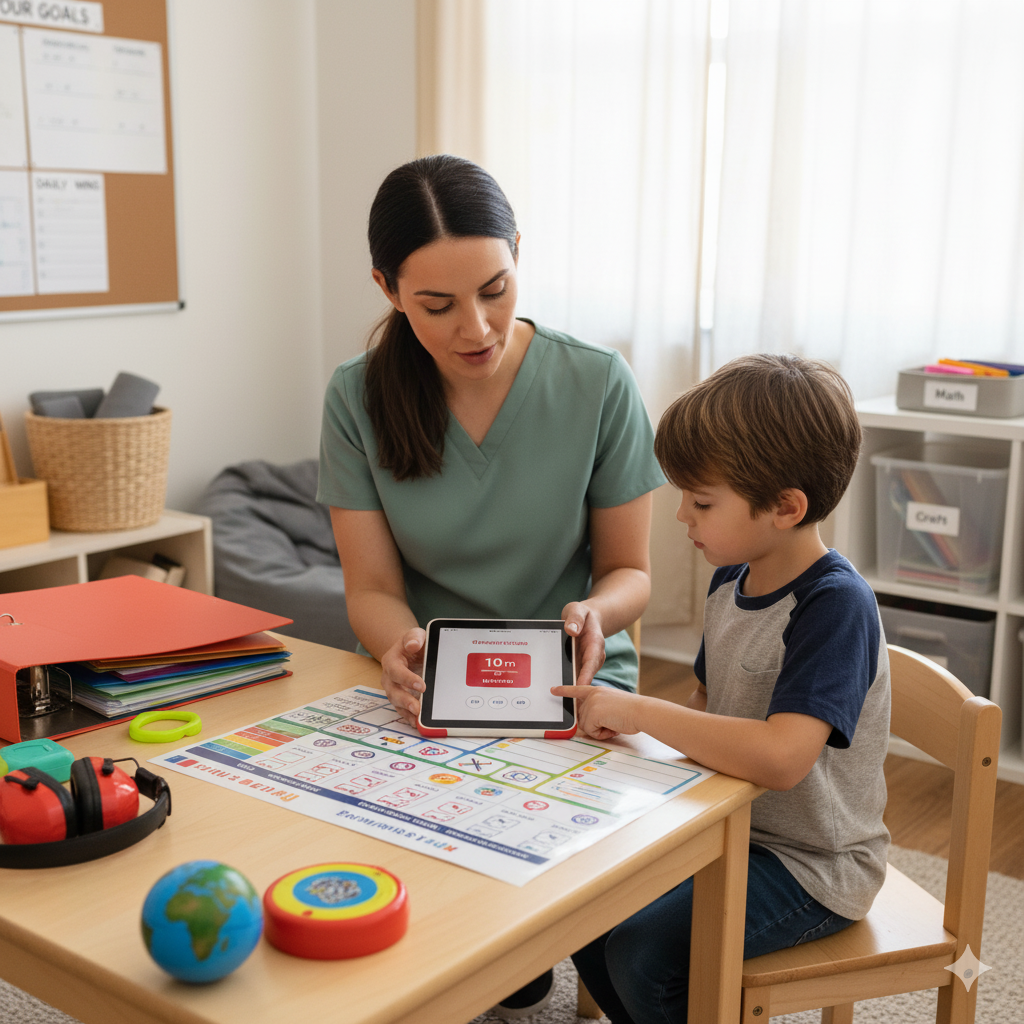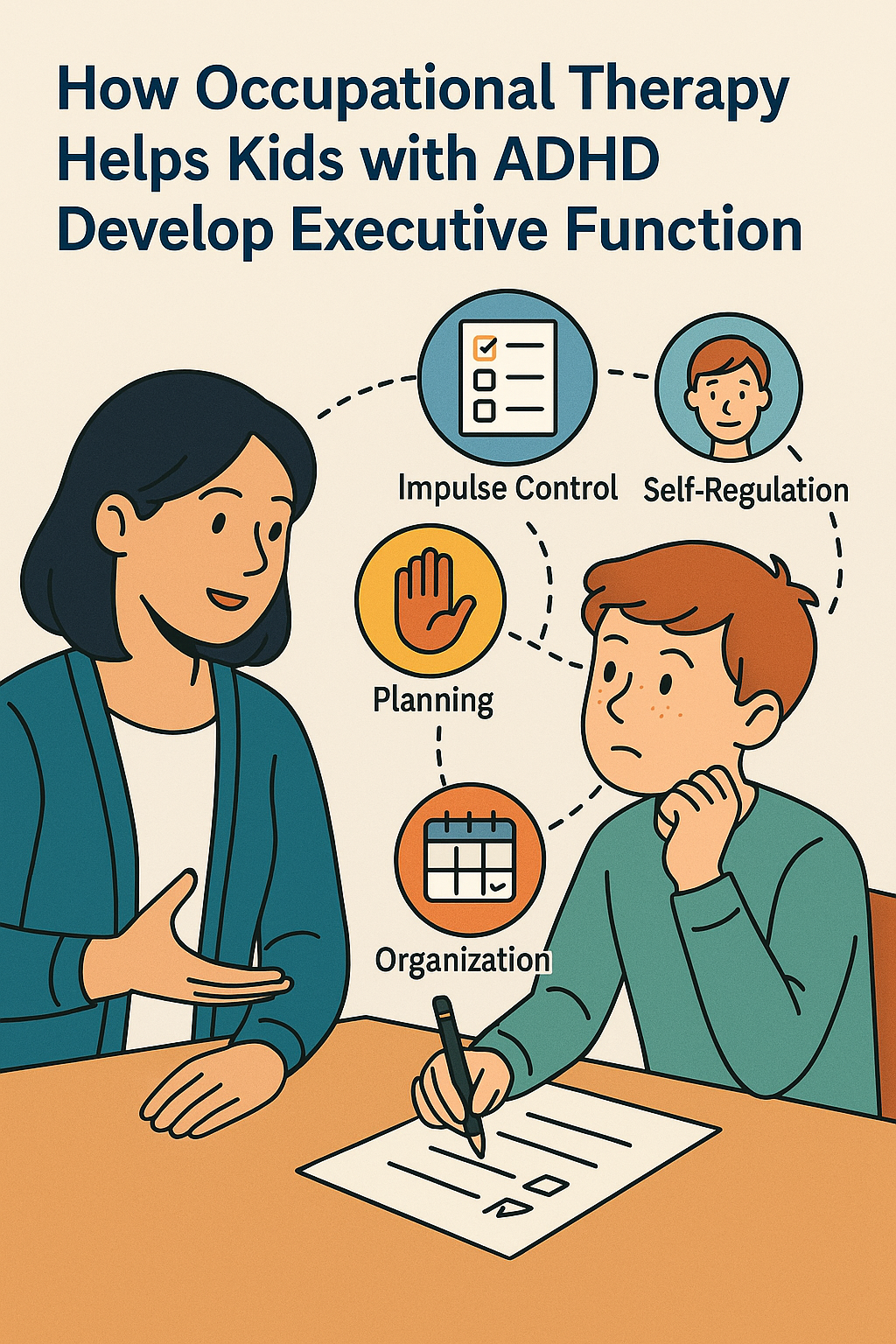
How Occupational Therapy Helps Kids with ADHD Develop Executive Function
Children with Attention Deficit Hyperactivity Disorder (ADHD) frequently struggle not just with focus and hyperactivity, but also with executive function — the brain’s “management system” for planning, organizing, initiating, monitoring, and adapting tasks. These deficits can affect academic performance, daily routines, social interactions, and emotional well-being.
Occupational therapy (OT) is uniquely positioned to support and scaffold the development of executive function in kids with ADHD. Through structured strategies, hands-on activities, and individualized interventions, OTs can help children gradually internalize executive skills and apply them across settings.
In this article, we will:
- Define executive function and its relevance in ADHD
- Illustrate how deficits in executive skills impact children
- Explain how occupational therapy assesses executive challenges
- Describe specific OT techniques and intervention models (including Cog-Fun)
- Share practical strategies and tools
- Highlight evidence supporting OT for executive function in ADHD
- Offer guidance for parents, teachers, and therapists collaborating
Let’s dive in.
What Is Executive Function — And Why It Matters in ADHD
Key Components of Executive Function
Executive function (EF) refers to a suite of higher-order cognitive skills that help individuals plan, monitor, and execute goal-directed behaviors. Some widely recognized components include:
- Inhibition / Impulse Control — the capacity to pause before acting, resist distractions or temptations
- Working Memory — holding and manipulating information temporarily in mind
- Cognitive Flexibility / Set Shifting — the ability to shift between tasks, adapt strategies, see alternate solutions
- Planning & Organization — foreseeing steps, arranging tasks, sequencing
- Task Initiation & Self‑Motivation — beginning tasks without undue procrastination
- Self‑Monitoring / Error Detection — reflecting on performance, catching mistakes, adjusting strategies
- Emotional / Behavioral Regulation — managing frustration, stress, and emotional reactions
These skills don’t operate in isolation — they interconnect, underpinning almost all aspects of daily life, from getting ready for school to completing homework to engaging in social interactions.
Executive Dysfunction in ADHD
Children with ADHD often show significant challenges in one or more areas of executive functioning. This can manifest as:
- Difficulty starting tasks, or getting “stuck”
- Forgetting instructions, losing materials, or failing to complete multistep tasks
- Trouble organizing their work, time, or schedules
- Easily distracted or sidetracked
- Impulsive responses, poor decision‑making
- Emotional outbursts, frustration, difficulty handling transitions
- Underestimating how long tasks will take
Because EF underlies self-regulated learning and daily functioning, weaknesses here amplify the core symptoms of ADHD and impede academic, social, and personal success.
A common intervention goal is to reduce the gap between what the child is supposed to do and what they can self-manage at any given age or developmental stage.
How Occupational Therapy Approaches Executive Function
Occupational therapy brings a functional, person-centered lens: rather than working only on “brain skills,” OTs embed executive function training within meaningful daily activities, adapting tasks and environments so that children can succeed and practice skills in context.
Below are key OT roles and perspectives in supporting EF in ADHD:
Assessment & Goal Setting
An OT begins by assessing which executive domains are most impacted and how they manifest in real life — at home, school, play. Assessment might include:
- Standardized tools (e.g. Behavior Rating Inventory of Executive Function — BRIEF)
- Observations of task performance
- Parent, teacher, and child interviews
- Real-world tasks (planning a project, organizing a bag, doing chores)
- Sensory, motor, and attentional screening to see contributing factors
Based on the assessment, the OT, child, and family set functional, meaningful goals, e.g. “The child will pack their backpack with all needed school materials in 10 minutes” or “will break homework into steps and complete them in order.”
Intervention Frameworks: Cog‑Fun / Cognitive‑Functional Models
One OT model designed specifically for EF in ADHD is Cog-Fun (Cognitive-Functional). This approach combines cognitive strategy instruction with functional tasks.
- It focuses on three execution strategies: Stop, Plan, Review
- The child learns to pause, think ahead, and reflect afterward
- Intervention is embedded in meaningful tasks (homework, chores, daily routines)
- The model is based on Person-Environment-Occupation (PEO) frameworks and often includes parent coaching to generalize skills
- Evidence from small experimental studies shows significant improvements in executive function and self-directed learning that persist over time
- The Cog-Fun method has also been adapted to adolescents to support more complex tasks and strategy use
Other occupational therapy models may integrate executive coaching, metacognitive strategy training, and task-specific scaffolding.
Embedded, Contextualized Training
Rather than isolating “EF drills,” an OT will often embed strategy instruction into real, meaningful tasks — chores, school assignments, household routines, craft projects, even play. This helps the child transfer skills across contexts.
Environmental & Task Adaptations
To support executive functioning, OTs modify the environment or task’s demands:
- Reduce distractions (visual or auditory clutter)
- Use checklists, visual schedules, timers, traffic-light cues
- Chunk tasks into manageable steps
- Provide scaffolding (e.g. cue cards, graphic organizers)
- Gradually fade supports as the child internalizes strategy use
- Use assistive technology or apps for reminders, alarms, planning tools
Metacognitive Coaching & Self‑Awareness
OTs often guide children to reflect on their thinking (metacognition):
- Prompt them to think about their approach (“What’s your plan?”)
- Encourage them to self-monitor (“How’s it going?”)
- Teach them to evaluate their performance and adjust
- Build self-awareness about executive strengths and challenges
Sensory & Self‑Regulation Strategies
Because many children with ADHD also struggle with arousal regulation or sensory processing, OTs may integrate sensory-based techniques to help the child calm, focus, and remain in a zone optimal for thinking. These may include:
- Movement breaks or proprioceptive input (e.g. pushing, carrying weighted objects)
- Deep pressure, compression, or tactile input
- Rhythmic activities, swinging, bouncing, or regulated motion
- Controlled sensory “warm-up” or “cool-down” routines
The idea is: if the child’s neurological regulation is more stable, they’ll be better able to deploy executive strategies.
Specific OT Strategies & Tools for Executive Function in ADHD
Below are concrete strategies and tools an OT might use or suggest, many of which you can adapt into your practice or share with families.
- Visual Schedules & Checklists
Using images, icons, or a step-by-step list helps children see the “map” of what to do. This supports planning, task initiation, and sequence tracking. OTs might create:
- Morning or evening routine boards
- Homework checklists with substeps
- “When-then” charts
- Visual timers or countdown timers to show how much time remains
- Task Chunking / Step-by-Step Planning
Break a complex assignment into smaller, manageable subtasks (chunks). For each chunk, the child can plan, execute, and self-check. This eases overwhelm and helps maintain focus.
- Use of External Memory Aids and Reminders
- Post-its, cue cards, color-coded systems
- Alarms, timers, phone or tablet reminders
- Digital apps (task managers, calendar apps)
- Sticky notes in strategic places
These support working memory and help shift cognitive load from the child’s mind to the environment.
- Strategy Training: Stop – Plan – Review
This three-step scaffold helps children slow down, think ahead, and reflect:
- Stop: Pause and think before acting
- Plan: Outline steps and sequence
- Review: Check work, self-monitor, adjust
Over time the child internalizes this loop, applying it independently.
- Metacognitive Coaching & Self-Reflection
OTs guide verbal prompts (“What’s your plan?” “Is this working?”) and foster self-awareness of strengths and challenges. Gradually, the child learns to ask themselves these questions.
- Play, Games, & Challenge Tasks
Therapeutic games and play tasks can implicitly train executive functioning:
- Board games (e.g. strategy games, card games)
- Puzzles that require planning or shifting
- Cooking, building projects, multi-step crafts
- Obstacle courses with sequential steps
- Dual-task or multitasking games to strengthen flexible attention
These tasks incorporate planning, monitoring, and adjusting in a motivating, engaging way.
- Incorporating Movement & Scheduled Breaks
Movement helps regulate arousal and attention. An OT might embed short, structured movement breaks between tasks, or alternate “thinking tasks” with “active tasks.”
- Gradual Fading of Supports
As the child becomes more consistent, supports are gradually removed — e.g. visual cues fade, reminders become less frequent — so that independence is built.
- Environmental Structuring
The OT might help redesign workspaces:
- Decluttered, minimal distractions
- Proper lighting
- Use of “focus zones”
- Seating adaptations (fidget tools, alternative seating)
- Consistent locations for materials, bins, labels
These environmental tweaks reduce extraneous demands on executive systems.
- Parent / Teacher Coaching & Collaboration
To support generalization across settings, OTs often train parents and teachers:
- Share consistent visual systems or schedules
- Use the same planning, cueing strategies
- Embed executive skill prompts during daily routines
- Monitor progress and scaffold support as needed
Because children must practice skills in multiple contexts, this collaboration is essential.
Evidence Supporting OT & EF Interventions in ADHD
It’s important to ground clinical practice in evidence. Below is a summary of relevant research.
Cog-Fun & Executive Function Improvements
A single-subject study of three children aged 9–10 implemented Cog-Fun intervention across 17 sessions and found:
- Statistically significant improvements in executive function (via Stroop test, Color Trails)
- T-scores for executive metrics decreased (indicating better performance)
- Self-directed learning improved
- Gains were maintained at follow-up
Other studies applying Cog-Fun to younger children and adolescents also report improvements in occupational performance, executive function, and strategy use.
Combined EF Training + Behavioral Parent Intervention
Research combining executive function training in children and behavioral interventions for parents shows promise. A study in China with 44 children indicated that incorporating parent coaching leads to greater gains in EF beyond training alone.
Meta- and Review-Level Evidence
While many studies examine cognitive training, EF coaching, or behavioral interventions, few isolate OT alone. Still, reviews suggest that multi-modal approaches that include cognitive strategy training, metacognitive coaching, and embedding in functional tasks tend to yield better generalization than “drill-based” training alone.
Moreover, broader OT literature recognizes the importance of integrating EF perspectives into pediatric therapy and school-based settings.
Emerging Findings: Physical Activity & Motor Skill Training
Recent preliminary research suggests that targeted physical activity programs may improve working memory and motor performance in children with ADHD, pointing toward synergy with OT motor-based interventions.
How to Implement OT-Based EF Support at Haghighati Academy
Below is a suggested roadmap and best practices you might apply or offer to your clients.
- Intake & Baseline Assessment
- Use structured interviews, parent/teacher questionnaires (e.g. BRIEF), and task-based observations
- Assess motor, sensory, attentional, and executive domains holistically
- Identify top 1–3 executive skill goals tied to meaningful functional tasks
- Develop a Collaborative Plan
- Co-create goals with child and family
- Choose intervention strategies (Cog-Fun, strategy training, scaffolds)
- Decide which supports and adaptations to begin with
- Plan for parent and teacher involvement
- Session Structure & Progression
Each session might include:
- Warm-up / sensory regulation activity
- Strategy teaching (e.g. Stop-Plan-Review)
- Embedded practice in a meaningful task (e.g. homework, craft, daily routine)
- Metacognitive coaching (pause, prompt reflection)
- Fade supports gradually
- Homework / carryover tasks (e.g. use visual schedule at home)
Track performance data — errors, prompts needed, time taken — to monitor progress.
- Generalization & Maintenance
- Encourage use of strategies across environments (school, home, extracurriculars)
- Regular check-ins with teachers
- Parent coaching and involvement
- Periodic “booster” sessions
- Fading toward independence
- Document Outcomes & Adjust
Monitor goals, refine strategies, shift focus as skills improve or needs change.
Practical Tips & Tools for Parents and Educators
Here are actionable ideas you can share with families and teachers:
- Use color-coded binders, folders, and labels
- Keep daily visual schedules and checklists
- Start tasks with brief planning discussion (5 min)
- Use timers (e.g. 10‑minute segments) to chunk work
- Provide “first-step” cues (e.g. “Open your notebook, title the page”)
- Incorporate movement breaks (e.g. jumping jacks, squeezing stress ball)
- Praise metacognitive effort (“I like how you stopped and checked your work”)
- Limit multitasking — one primary task at a time
- Use consistent systems across home and school
- Gradually fade scaffolds as independence improves
Conclusion
Executive functioning challenges are a central and often underappreciated aspect of ADHD. Because they underlie a child’s ability to plan, monitor, adjust, and complete tasks, deficits here can amplify academic, behavioral, emotional, and organizational difficulties.
Occupational therapy offers a powerful, functional, and context-sensitive approach to scaffold, teach, and gradually internalize executive skills in children with ADHD. Models like Cog-Fun, strategy instruction, embedded practice, metacognitive coaching, and environmental modifications work in combination to help children become more self-regulated and successful across settings.
At Haghighati Occupational Therapy Academy, integrating evidence-based OT strategies for executive function can help your young clients not only manage ADHD symptoms better, but also build the lifelong cognitive tools they need to self-manage, grow, and thrive.

